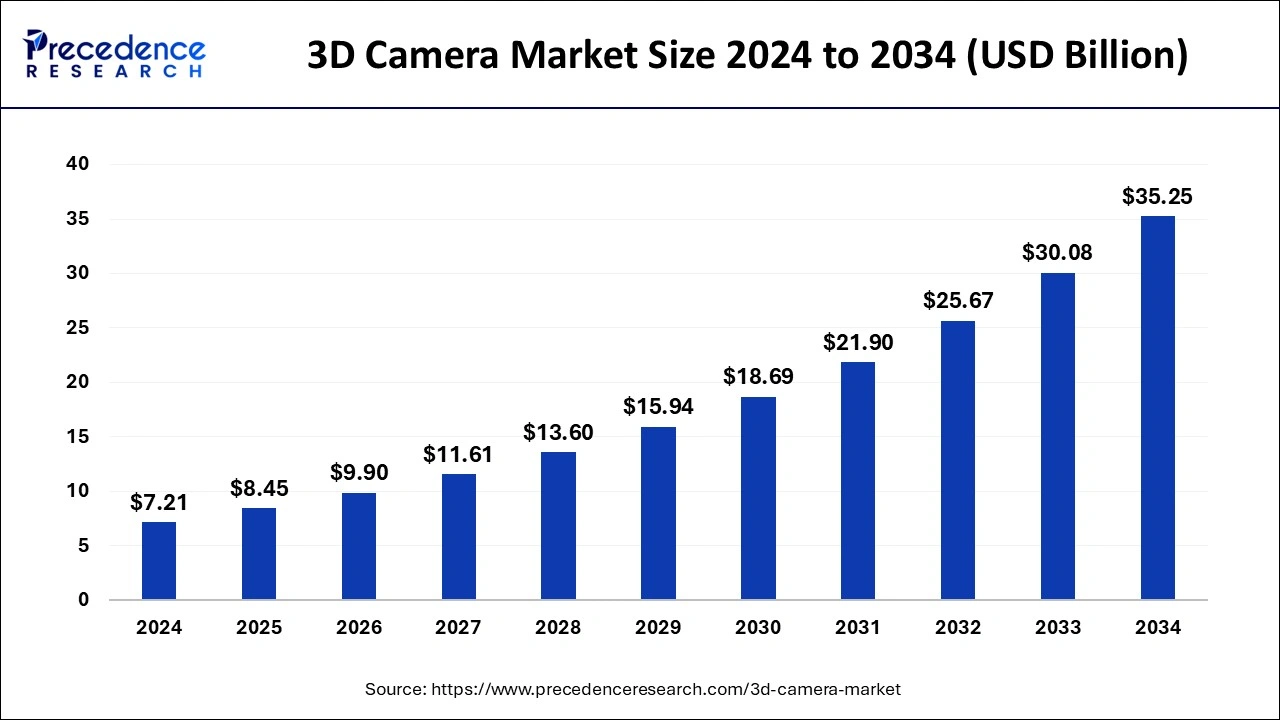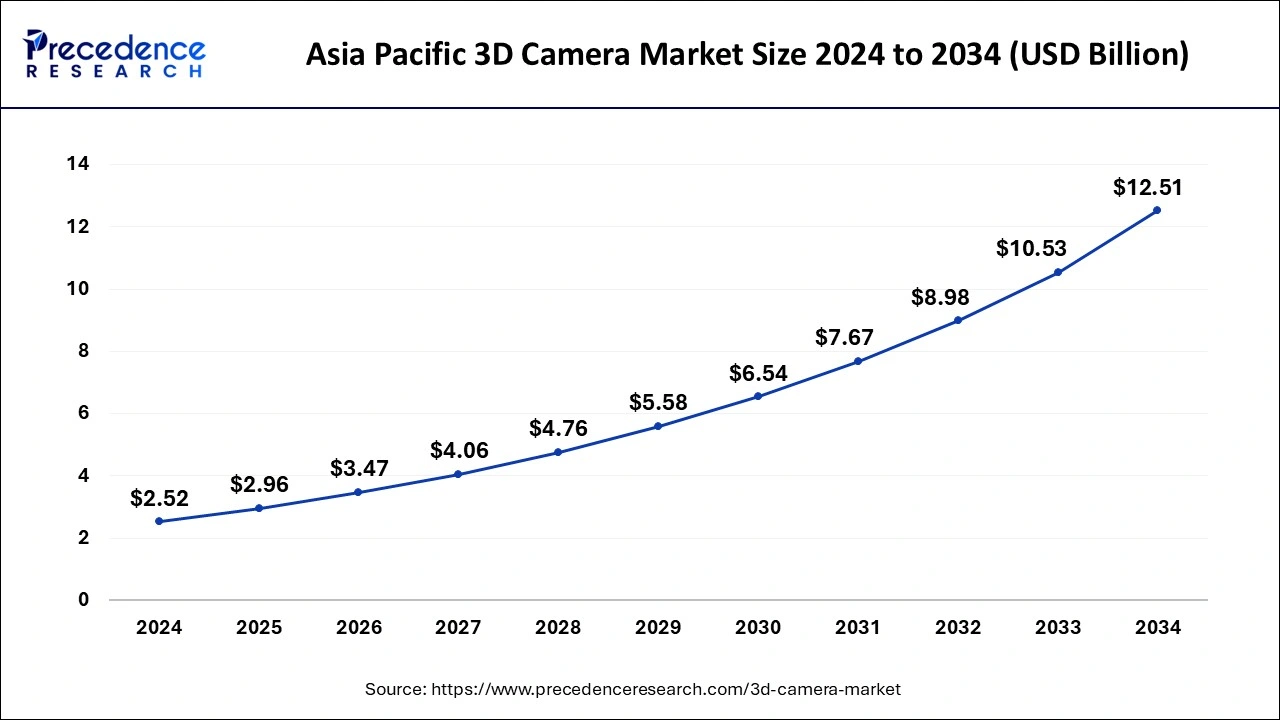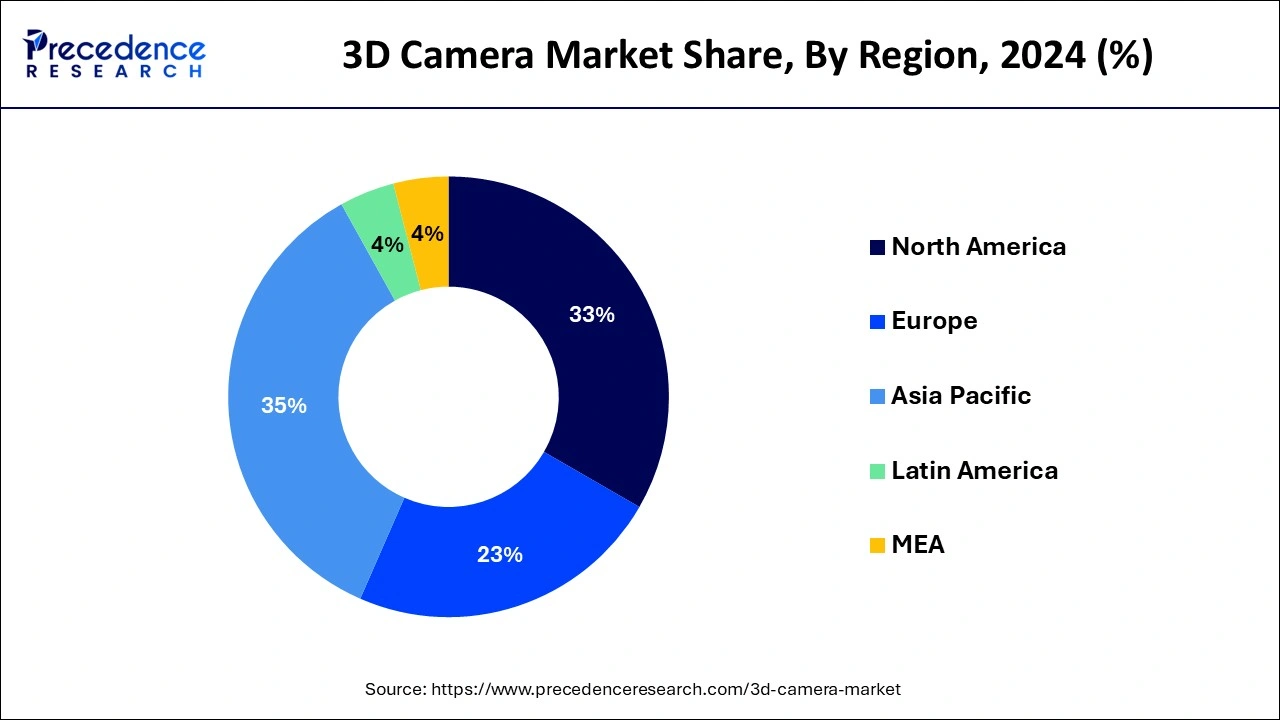List of Contents
What is the 3D Camera Market Size?
The global 3D camera market size is calulated at USD 7.21 billion in 2025 and is anticipated to reach around USD 35.25 billion by 2034, growing at a CAGR of 17.20% from 2025 to 2034.The growthof the 3D camera market is majorly driven by the improvement in 3D scanning technology, rapid advancements in computational photography, increasing use of technologies like self-driving cars, drones, and robots, and rising industrial applications of 3D cameras.

Market Highlights
- Asia Pacific dominated the global 3D camera market with the largest market share of 35% in 2024.
- Middle East and Africa (MEA) is expanding at a double digit CAGR of 21.1% during the forecast period.
- By technology, the time-of-flight segment dominated the market in 2024.
- By application, the professional camera segment accounted for the highest market share in 2024.
Market Size and Forecast
- Market Size in 2025: USD 8.45 Billion
- Market Size in 2026: USD 9.90 Billion
- Forecasted Market Size by 2034: USD 35.25 Billion
- CAGR (2025-2034): 17.20%
- Largest Market in 2024: Asia Pacific
- Fastest Growing Market: Middle East and Africa
Market Overview
A 3D camera is a type of imaging technology that gives images the appearance of depth to mimic three-dimensional perspectives as perceived by human binocular vision. A single lens that changes position is used by some 3D cameras, while others employ two or more lenses to record different points of view.
The parallax effect is produced by combining the pictures from the two lenses to produce the 3D effect. When looking at an object across two lines of sight, parallax happens. When volumes, forms, and 3D positions and orientations of objects are needed, 3D image processing is quite helpful. It is a depth-sensing innovation that improves camera functionality for object and facial recognition. Utilizing optical technology, 3D sensing technology imitates human vision, enabling the development and integration of augmented reality, artificial intelligence (AI), and the Internet of Things (IoT). This gives consumer applications new opportunities.
The key driver of the worldwide 3D camera market is the entertainment sector's growing demand for and popularity of 3D content. The need for 3D cameras is also being driven by the expanding applications of 3D imaging in home automation, robotics, virtual reality, and video surveillance. Major reasons boosting the demand for 3D cameras include the rising popularity of 3D TVs and the comparatively simple integration of 3D cameras into smartphones.
Integration of Artificial Intelligence in 3D Cameras
Artificial intelligence (AI) integration has opened up new possibilities and paved the way for the future of 3D cameras. 3D cameras offer depth information and AI algorithms process this data for several crucial applications, enabling advanced capabilities including motion tracking, object recognition, and scene analysis. 3D vision technology enters the equation, offering Artificial intelligence with the precise visual data necessary to interpret and interact with the physical world. AI-enhanced 3D cameras are widely used across various industries, including robotics, manufacturing, gaming & entertainment, healthcare, and autonomous vehicles. AI integration offers high-quality assurance, navigation assistance, and object identification.
By leveraging the strengths of AI in 3D vision assists in achieving new levels of accuracy, efficiency, and reliability. This camera comes equipped with several advanced features that enable it to detect objects, mark serial numbers, and others. The AI-powered 3D camera allows it to detect objects even in cluttered workspaces which makes it the perfect choice for use in manufacturing and production environments.
Key Factors Influencing Future Market Trends
- Healthcare Imaging: The healthcare sector has begun using 3D cameras to support medical images, guide surgeries, and monitor patients. By utilizing these 3D cameras, the anatomical structure can be viewed in three dimensions, allowing for a more accurate diagnosis and a proactive approach.
- Customized 3D Scanning Solutions: Custom 3D scanning enables the manufacturing, building, and architectural sectors to deal with their specific work issues. Since many industries want customized solutions, companies that are good at innovation in customization will be very competitive in the growing 3D camera market.
- Miniaturization and Wearable Devices: Integrating 3D cameras into various gadgets does not affect their functioning, so they offer instant spatial view, gesture recognition, and health monitoring. This trend enables a wider adoption of immersive technology in consumer sectors, for healthcare, and in factories.
- AI Integration: When AI is combined with 3D cameras, students and researchers can use them for live object detection, pattern spotting, and quick data analysis. They will provide new creative improvements and automation in multiple industries.
3D Camera Market Growth Factors
- The rising demand for 3D cameras from various industries such as entertainment, gaming, manufacturing, healthcare, autonomous vehicles, and others is expected to contribute to the overall growth of the 3D camera market.
- The increasing use of virtual reality (VR), augmented reality (AR), and 3D printing sectors is expected to promote the growth of the market.
- The surge in virtual reality applications, home automation applications, and automated operations in industries are the primary drivers for the rapid growth of the market.
- The significant rise in industrial applications of 3D cameras particularly in manufacturing and quality control significantly bolstering the growth of the global 3D camera market.
- The increasing adoption of smartphone cameras is expected to accelerate the market's growth during the forecast period.
Market Scope
| Report Coverage | Details |
| Market Size in 2025 | USD 8.45 Billion |
| Market Size in 2026 | USD 9.90 Billion |
| Market Size by 2034 | USD 35.25 Billion |
| Growth Rate from 2025 to 2034 | CAGR of 17.20% |
| Largest Market | Asia Pacific |
| Base Year | 2024 |
| Forecast Period | 2025 to 2034 |
| Segments Covered |
Technology, Types, Application, and Region |
| Regions Covered |
North America, Europe, Asia-Pacific, Latin America, and Middle East & Africa |
Market Dynamics
Key Market Drivers
- A rise in 3D camera demand in the entertainment Industry - The market for 3D cameras has become more accessible to new players as a result of the sharply rising demand for 3D films, games, and videos. The growth of visual applications in the entertainment industry is driving the market for 3D cameras. The entertainment sector is expected to grow globally as a result of the use of 3D technology in cameras. For instance, Weta Digital's most modern camera was utilized to film a movie in Hollywood, and DNEG, Framestore, and MPC produced stunning futuristic cityscapes. As a result of the 3D camera's success in the movie industry, many new 3D filmmakers have emerged, and as more 3D movies are created in the future, a long-term 3D camera industry will develop.
- Increasing use of 3D cameras in automobiles - The use of 3D cameras in the automotive industry is anticipated to increase as 3D camera technology advances. ZF has created a 3D (IOS) inside the camera that can easily improve automation and safety systems by identifying and locating people within the car. To detect the position of the car on the road, 3D cameras are used in automobiles called range cameras. These sensors in the system alert the driver when a vehicle is coming up from behind, enabling him to change lanes. Additionally, it detects lane deviation and vibrates the seat to alert the driver. These developments will hasten the adoption of 3D cameras in the market for ADAS and safety systems for automobiles. The demand for 3D cameras is also increasing as self-driving cars and autonomous trucks gain popularity in the automotive sector. 3D cameras are commonly employed in autonomous vehicles to enhance drivability.
Key Market Challenges
- High cost of 3D camera - Since the technology is still in its early stages, there are additional difficulties that the manufacturers must solve during the pricey 3D camera production process. Cost concerns are thus the main hindrance to the market expansion of 3D cameras. Due to their expensive price, 3D cameras are only appealing to a small segment of the market. Despite the increased capabilities, sales are thus lower than for other camera technologies, such as 2D. This is primarily due to the expense problem.
Key Market Opportunities
- The rise in home automation - The rise in disposable income and high living standards are giving market opportunities for the 3D camera market owing to the features of the 3D camera. The demand for 3D technology has lucrative opportunities in the coming years.
Segments Insights
Technology Insights
The time-of-flight segment dominated the market in 2024. This is because the technology is widely used in a variety of applications, including smartphones, drones, healthcare, industrial, and automotive. In addition to being resistant to ambient time, the system only considers one viewpoint while calculating depth, which makes it immune to occlusions and shadows while preserving sharp depth borders. As a result, maintaining safety through the recognition of moments and gestures and the provision of real-time information is most desired in the automotive and industrial sectors.
Over the forecast period, stereo vision is expected to maintain its position in 3D cameras. Over the anticipated time frame, the market is expected to grow at a CAGR of 36%. These technologically advanced cameras are inexpensive and simple to design.
Application Insights
The professional camera segment accounted for the highest market share in 2024, the segment has dominated the market and it will continue to grow well in terms of revenue. As the market for 3D movies expands, more professional 3D cameras are anticipated to be used to record live-action movies. Stereo cameras are used to capture motion pictures. Professional 3D cameras are preferred over pricey computer-generated imagery (CGI) to save time and money. The market for 3D cameras is primarily driven by the increased use of these cameras to record 3D content in media and entertainment. The rising use of expert 3D cameras in sectors including manufacturing, building, civil infrastructure, and historical site management is another development driver for the sector.
Over the projected period, it is anticipated that the sector for smartphones and tablets will expand the fastest. The increase is anticipated to be driven by the rising demand for sophisticated cameras equipped with cutting-edge technologies that improve picture and video quality by detecting motions. Among youthful consumers, features like high performance, HD clarity, and real-time sensing are becoming more popular.
Regional Insights
Asia Pacific 3D Camera Market Size and Growth 2025 to 2034
The Asia Pacific 3D camera market size is estimated at USD 8.45 billion in 2025 and is anticipated to be surpass around USD 12.51 billion by 2034, rising at a CAGR of 17.37% from 2025 to 2034.

Asia Pacific dominated the global 3D camera market with the largest market share of 35% in 2024. Due to the significant smartphone sector in the region, which is expected to be a target industry for 3D cameras over the projection period, Asia Pacific is a very lucrative region of the worldwide market. The growth of the region's construction, automotive, and healthcare industries is having a big positive impact on the market for 3D cameras. In 2024, the market for 3D cameras saw the biggest revenue share in the Asia Pacific region. This is because more people are using smartphones, the entertainment sector is expanding, there is more money available, and fewer people possess cameras. Additionally, the growth of the regional market would be further boosted by the development of the industrial sector in the region's developing countries.

A significant portion of the global market for 3D cameras is projected to come from North America due to the region's rapid adoption of technologies that are increasing the demand for 3D cameras. 3D cameras are widely used in the region in the fields of construction, surveying, surveillance, indoor mapping, entertainment, and sports.
3D Camera Market Companies
Recent Developments
- In May 2025, Photoneo, a 3D vision technology leader, announced the introduction of – MotionCam-3D Color (Blue) – to build on the success of their pioneering flagship. This cutting-edge 3D camera expands the possibilities of scanning with an extraordinary 50% improvement on the 3D scanning capability.
- In April 2024, Cognex Corporation announced the launch of the In-Sight L38 3D Vision System that combines AI with both 2D and 3D vision technology, allowing for a variety of inspection and measurement tasks. The vision system produces a unique set of projection images that captures 3D data in a simple 2D format for labeling/training, as well as unearths features that would not be visible in conventional 2D imaging.
- In March 2024, Matterport, Inc. launched the upgraded case and packaging of its Pro3 camera to increase the sustainability and functionality of its 3D cameras. The carrying case purchase was designed to make it easier to transport the camera.
- In October 2024, the Apple 8K 3D camera was unveiled with a “Submerged” short film for Vision Pro.
- In December 2024, PxE Holographic Imaging to Debut Next-Generation 3D Camera at CES 2025. PxE Holographic Imaging's RGB-IR-Depth camera turns standard 2D cameras from smartphones, laptops, cars, and more into a 3D camera, changing the foundation of digital cameras from 2D to 3D and beyond in consumer electronics, automotive, security, precision imaging, robotics, drones, and other camera-based systems.
Segments Covered in the Report
By Technology
- Time of Flight
- Stereo Vision
- Structured Light
By Types
- Target Camera
- Target-free Camera
By Application
- Professional Camera
- Smartphone and Tablets
- Computer
- Others
By Region
- North America
- Europe
- Asia-Pacific
- Latin America
- Middle East & Africa (MEA)
For inquiries regarding discounts, bulk purchases, or customization requests, please contact us at sales@precedenceresearch.com
Frequently Asked Questions
Tags
Ask For Sample
No cookie-cutter, only authentic analysis – take the 1st step to become a Precedence Research client